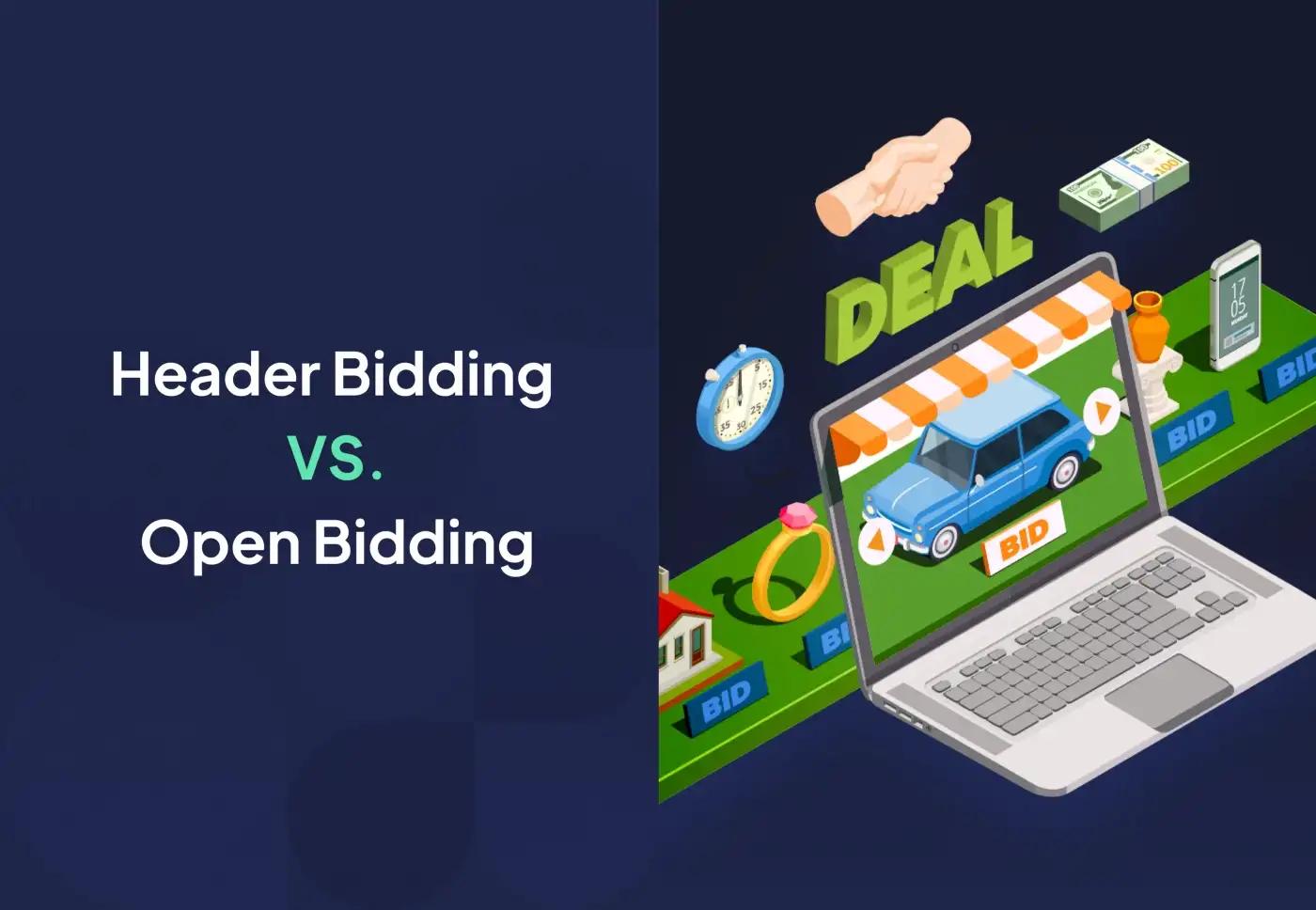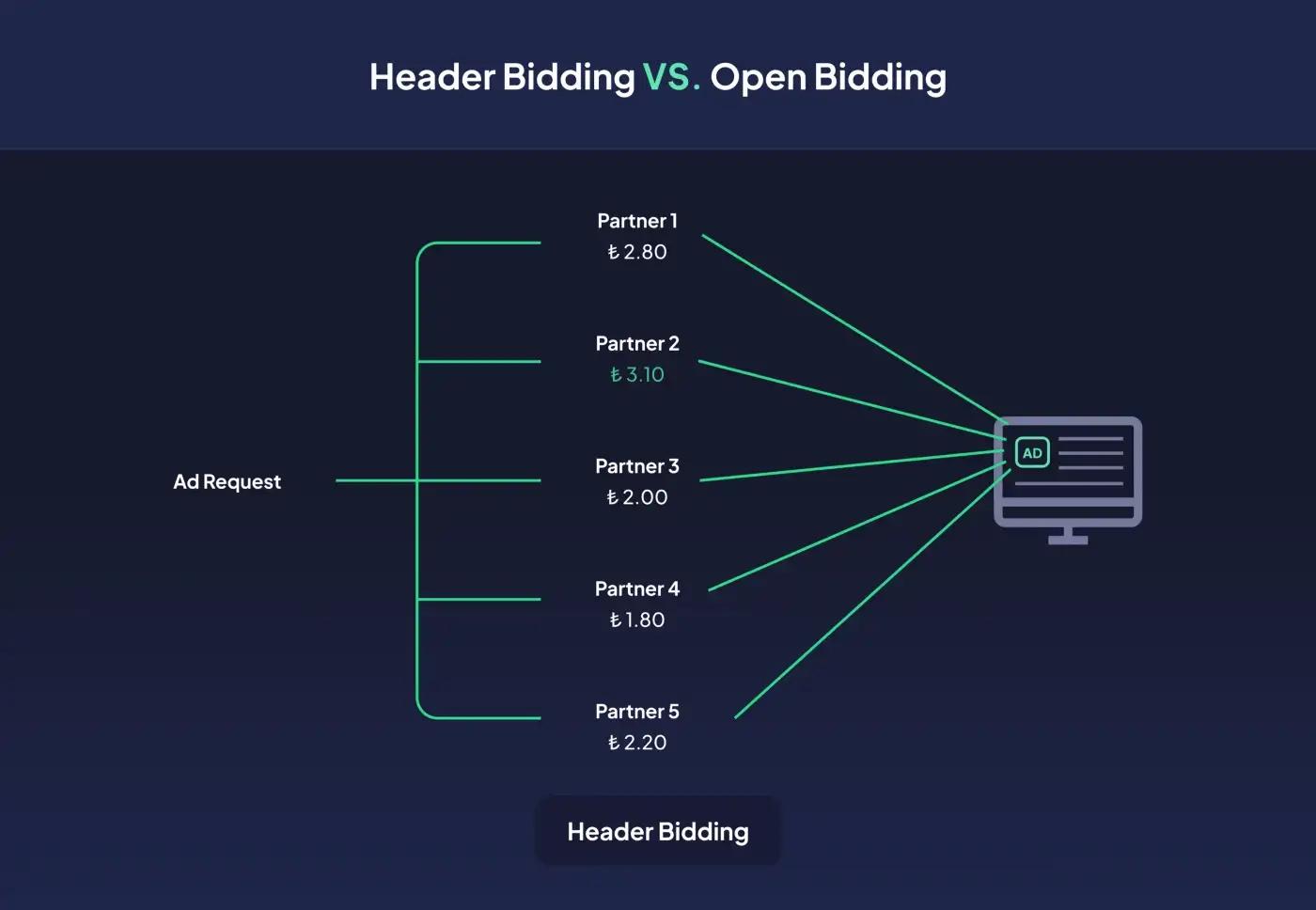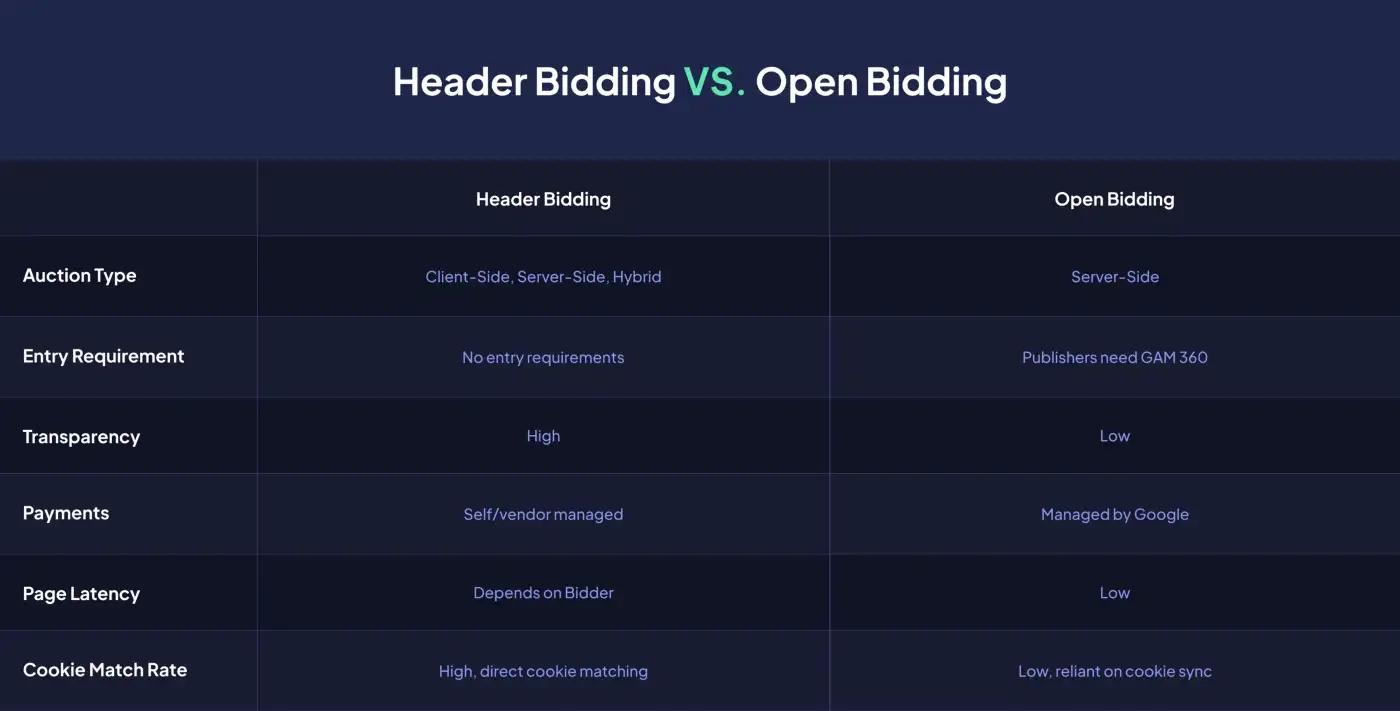Header Bidding vs. Open Bidding
Digital Advertising
.
6 min read
Header bidding can be self-hosted or managed, has a large network of demand partners, and increases revenue immediately with higher CPM and fill rates. Open Bidding is, however, only accessible to the largest publishers on a direct basis.

Programmatic advertising has one clear goal: to increase efficiency for advertisers and publishers. Fundamental to programmatic advertising is header bidding, a sell-side technology that allows publishers to offer ad impressions across multiple advertising marketplaces, such as ad networks, ad exchanges or SSPs.
With its Doubleclick AdExchange marketplace solution, Google had a particularly strong position in the programmatic advertising market before Header Bidding appeared. Publishers were able to get into programmatic selling with little effort and without their own sell-side platform, i.e. only with the Google Adtech stack. The only requirement for publishers: the use of Google’s own ad server Google Ad Manager (formerly DFP)
To stand up to this walled garden solution, several adtech providers came together under the direction of Appnexus (now Xandr) and Rubicon Project (now Magnite) and finally published the header bidding protocol called Prebid. (prebid.org) The Prebid wrapper is a script allowing publishers to send ad requests simultaneously to several SSPs so that each bid competes with one another in an auction. Hence, header bidding took the programmatic exchanges to a step further from its predecessor, the waterfall principle, in which only one SSP offered the ad space on the website to its connected DSPs, hence represented a strong alternative to Google’s AdTech dominance.
What’s Header Bidding?

Header bidding’s ultimate goal is generating as much demand as possible for each ad request and thus maximizing advertising revenues. By using header bidding, each individual ad impression can be offered simultaneously on almost all relevant platforms — via a wrapper — without having to accept a technical reduction in inventory quality.
*The wrapper is a script that is usually integrated in the header of the website and sends the individual ad request, including the environment and user information, to the integrated exchanges simultaneously. They then auction the impression on their platform and respond with a bid if the auction was successful. The demand increases with each additional demand partner, as additional agency budgets and buyer networks compete for inventory.
Wrapper Types Explained
Header Bidding Wrappers enable you to work with multiple header bidding solutions at the same time and thus establish an effective connection to multiple SSPs and ad exchanges. Not all wrappers are created equal. A distinction is made between the following offers:
Client-side wrapper: Tags that make multiple asynchronous calls to demand sources directly from the browser.
Server-side wrapper (S2S): A tag that makes a single call to an SSP, from one server to the other. The SSP’s server then calls up every source of demand.
Hybrid wrapper: A solution that enables publishers to switch between client-side and server-side solutions with a single tag. Currently, most publishers use wrappers in a hybrid setup, which means they use both server-, and client-side wrappers.
The evolution of header bidding over time
With header bidding, for the first time, non-Google providers were also able to bid on the publisher’s inventory in real time. Third-party providers — such as ad exchanges and other real-time providers — can submit a bid to Google Ad Manager by integrating a header tag. The Google Ad Manager recognizes the third party provider and activates a line item within the ad server by allowing it to compete with all the others, including the Google Ad Exchange AdX. The effects were felt immediately: Google had to compete with third-party vendors, even pay up to 50% and more for publisher inventory.
Publishers quickly realized the positive impact that adding header bidding partners had on their sales. They believed that having more header bidder providers on their pages would increase sales. As a result, they integrated more and more of them, increased competition and pushed more onto the market. Today there are already over 30 companies offering header bidding solutions. A publisher is able to use app. 15 of them. The “the more, the better” logic made perfect sense from a publisher’s perspective and therefore developed quite rapidly.
What is Open Bidding?
Google’s server-to-server technology, open bidding enables publishers to invite multiple third-party ad exchanges in an auction for the inventory. As opposed to the traditional waterfall process, which prioritized demand partners based on historical averages and called them one by one, open bidding allows you to run a unified auction which forces all partners (including Google) to auction simultaneously. The demand partners compete on a first price basis against Google’s Ad Manager line real-time via dynamic allocation. Dynamic allocation, simply put, is the term that Google uses for the automatic process that allows “all non-guaranteed demand — Open Auction, Open Bidding, and remnant line items — to compete in real-time with guaranteed line items.”
Comparison of Pros and Cons: Header Bidding vs. Open Bidding

Join to get free updates every week
A system of control and transparency: With header bidding, the wrapper provides publishers with easy access to add and remove demand sources and set bid timeouts. In addition, the publisher can see who is bidding and when. Data like this is extremely valuable when it comes to making informed decisions about which demand partners to drop or keep, defining optimal timeouts, and determining geo-based bidder optimizations. Open Bidding auction data, by contrast, is a black box. Though Google offers advanced analytics and reporting, publishers aren’t able to see the bids made by demand partners for every auction.
Cookie matching: In header bidding auctions, advertisers can directly access cookies since the auctions are held on client-side platforms thus can target and retarget specific users, resulting in higher revenue for publishers.(Client-Side Header Bidding Vs Server-Side Header Bidding — What to Choose?, 2021) Open bidding does not match cookies hence it is less precise and some bid opportunities can be lost. As a result, open bidding falls short when it comes to matching with advertisers. With the elimination of cookies by 2023, Universal ID solutions are aiming to support prebid. (Module — User ID for Header Bidding, n.d.)
Standard for the industry: Many publishers and advertisers implement client-side header bidding, so a lot of ad partners and demand partners are familiar with it. By placing JavaScript code into your website header, you can apply the header bidding process to your website. Publishers can then contact demand partners.
However for open bidding Publishers must use one of Google’s modules, such as a Google Ad Manager or AdX server, to participate.
Conclusion:
Which one will work best depends on the specific KPI needs. Header bidding can be self-hosted or managed, has a large network of demand partners, and increases revenue immediately with higher CPM and fill rates. Open Bidding is, however, only accessible to the largest publishers on a direct basis. Open bidding has long been known to produce high commissions for publishers, but overall, the bidding is a structure to increase the gain of publishers. So if you are not a big publisher, it is easy to slip into a zero-sum game. With the latest header bidding advancements, both client-side and server-side header bidding have caught up on latency. Both approaches are pretty much equal in terms of speed. However with open bidding potential risks arise from a lack of control and transparency.
The growth of header bidding over time has advanced programmatic advertising and democratised access to inventory, enabling buyers to better forecast their campaigns and bid strategies. (IAB Europe, n.d.) Adoption of header bidding is foreseen continue to grow, and the programmatic ecosystem will become more efficient and standardized than ever before.
Resources:
Client-Side Header Bidding Vs Server-Side Header Bidding — What to Choose? (2021, May 26). Automatad. Retrieved January 14, 2022, from https://headerbidding.co/waterfall-vs-client-side-vs-server-side-header-bidding/
Module — User ID for Header Bidding. (n.d.). Prebid.Org. Retrieved January 14, 2022, from https://docs.prebid.org/dev-docs/modules/userId.html
IAB Europe. (n.d.). Iabeurope.Eu. Retrieved January 14, 2022, from https://iabeurope.eu/blog/member-blog-header-bidding-brings-transparency-to-programmatic/
Share
